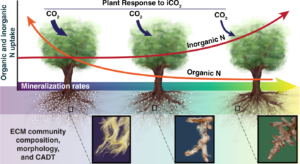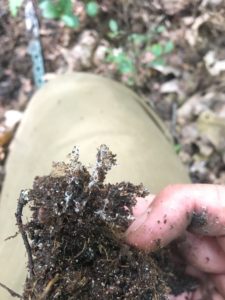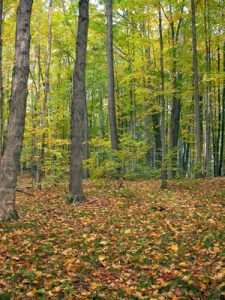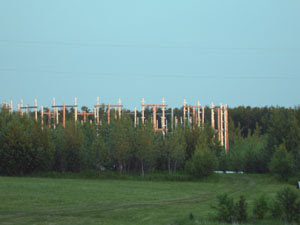
Collaborators
Inés Ibáñez & Donald Zak, School of Environment and Sustainability, University of Michigan, Ann Arbor, MI
Summary
Forests have the capacity to mitigate global warming by absorbing carbon dioxide from the atmosphere and storing it in plant tissues. However, plant uptake of carbon dioxide is controlled by the availability of other resources, like nitrogen, an element essential in photosynthesis. Because the supply of nitrogen is limited in most forests, trees could be prevented from reaching their maximum carbon uptake potential. Understanding how new mechanisms work for acquiring nitrogen, where it takes place in the landscape, and which trees benefit most, enables better predictions of forest carbon storage and more accurate quantification of climate mitigation potential of forests.
This project evaluates how trees potentially access nitrogen that is bound in soil organic matter using ectomycorrhizal fungi. Further, the project assesses how access to this additional nitrogen could increase net primary productivity, especially under elevated atmospheric carbon dioxide concentrations. The assumption that ectomycorrhizal fungi increase tree productivity has previously been untested under field conditions. This work directly investigates this mechanism through a field experiment along a nitrogen gradient as well as use results from Bayesian models to improve the accuracy of terrestrial biogeochemical models. This research investigates 1) the conditions under which organic nitrogen contributes to plant nutrition; 2) the magnitude of that contribution to tree growth; and 3) the effect of organic nitrogen on tree productivity under elevated atmospheric carbon dioxide concentrations.
Funding Source: National Science Foundation

The rate at which plants photosynthesize, thereby capturing carbon from the atmosphere, is limited by a number of factors including the availability of nitrogen (N) in soil. Past research has presumed that plants exclusively use inorganic nitrogen (ammonium, nitrate) for growth. Current work suggests that plants may have access to additional types of nitrogen in organic N forms, also present in the soil. If and how plants access these other forms of N will impact their growth and ability to pull CO2 from the atmosphere.
Recent global level modeling efforts indicate that trees that associate with ectomycorrhizal fungi mutualists will be fertilized by increasing concentrations of atmospheric CO2 due to the ECM acting to extend the root system and increasing plant access to limiting nutrients, including organic N. Other evidence suggests that C storage in forest soils may be due to enzymatic activity of ECM instead. Both models rely on the untested claim that ECM fungi mobilize N form SOM and provide access to this N to host trees. Since direct evidence that ECM fungi can function in this role is lacking, the goals of this project are to understand the extent to which root-associated fungi are liberating organic N from soil for trees and how they do so. This involves investigating if ECM have these genes, how common they are in varied N-available environments and if these genes are expressed under field conditions.

Collaborators
Kurt S. Pregitzer, Andrew Burton & Erik Lilliskov, School of Forest Resources & Environmental Science, Michigan Technological University, Houghton, Michigan 49931
Abstract

Collaborator
Kurt S. Pregitzer, School of Forest Resources & Environmental Science, Michigan Technological University, Houghton, Michigan 49931
Abstract
A major uncertainty in predicting ecosystem response to a changing environment is the extent to which increases in plant and ecosystem productivity will be sustained as CO2 continues to accumulate in the Earth’s atmosphere. For example, there is uncertainty regarding the specific ways in which higher levels of tropospheric O3 will interact with rising CO2 to alter plant growth, and how they might cascade through terrestrial ecosystems to impact decomposer communities in soil, which further control the flow of energy and nutrients in forest ecosystems. This project seeks to understand the mechanisms controlling ecosystem response to elevated CO2 and O3, and it is based on the premise that plant-microbe interactions in soil mediate key feedback mechanisms controlling ecosystem response to environmental change. The project centers on a conceptual model and coordinated series of hypotheses that link production and biochemical changes in plant litter to physiological changes in soil microbial communities. Each hypothesis is being tested at the FACTS II FACE experiment in Rhinelander, Wisconsin, a free-air release experiment capable of addressing how CO2 and O3 will interact to alter the structure and function of forest ecosystems. Previous results demonstrate that increases in plant growth under elevated CO2, and its diminishment by elevated O3, have altered fine root production and biochemistry, substrate availability for microbial metabolism, the composition of soil fungal communities and the formation of soil organic matter. This current project addresses key questions that remain unanswered: Why has elevated O3 accelerated fine root mortality in aspen, while net primary productivity has declined? Will this response be consistent across ecologically distinct communities, or will it diverge among community types? Why has greater below ground litter production under elevated CO2 elicited a disproportionately greater increase in cellulose degradation by soil fungi, when there is no change in fine root biochemistry? How has fine root and microbial metabolism changed such that the greatest soil CO2 flux is now occurring in the CO2 and O3 combination treatment? Will plants growing under elevated CO2 accumulate more N over time? Will O3 negate this response? This project will answer these questions and will provide insight into the mechanisms by which altered plant growth and tissue biochemistry under elevated CO2 and O3 will modify soil microbial communities and the ecosystem-level cycling of C and N in ecologically and economically forests in the Upper Great Lakes region.